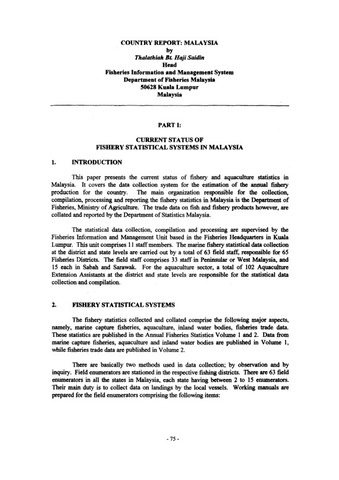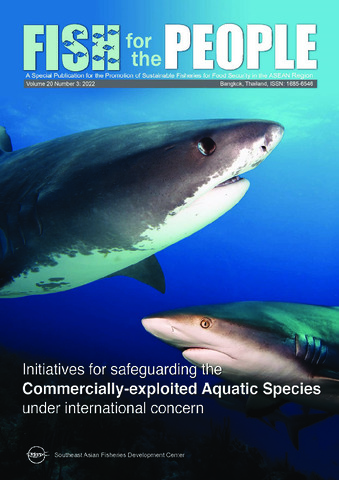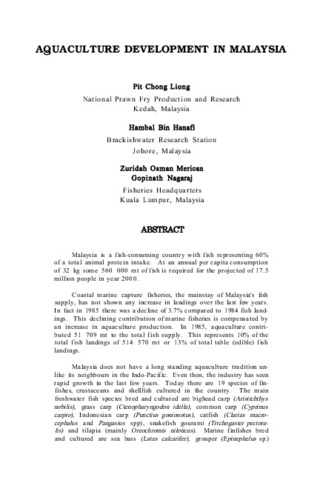ສະແດງບັນທຶກທີ່ງ່າຍດາຍສໍາລັບລາຍການ
Fisheries statistics in Brunei Darussalam
Share
| dc.contributor.author | Salleh, Hj. Abdul Halidi bin Mohd. | |
| dc.date.accessioned | 2019-08-30T06:32:12Z | |
| dc.date.available | 2019-08-30T06:32:12Z | |
| dc.date.issued | 1997 | |
| dc.identifier.citation | Salleh, Hj. A. H. bin Mohd. (1997). Fisheries statistics in Brunei Darussalam. In Fishery and Aquaculture Statistics in Asia: Proceedings of the FAO/SEAFDEC Regional Workshop on Fishery Statistics, Bangkok, Thailand, 19-21 August 1997: Vol. II. Fishery and Aquaculture Statistical Systems and Programs (pp. 6-14). Bangkok, Thailand: Secretariat, Southeast Asian Fisheries Development Center. | en |
| dc.identifier.uri | http://hdl.handle.net/20.500.12066/5400 | |
| dc.description.abstract | Fishery statistics in Brunei Darussalam have been collected by the Department of Fisheries since the 1940s. In the early 1980s, a number of statistics were collected, such as catch and effort data of artisanal fishermen, aquaculture statistics, processing statistics as well as data from major wet markets focusing on the amount, prices of marketed fish either from the local fishermen or imported. In 1984, the collection of statistics on commercial fishing was started. The statistics have been used in the formulation of fishery management and development policies as well as for sectoral development. Following a brief account of the responsibility and statistic collections of the Department of Fisheries, an examination is made of employment in the fishery sector, fisheries production, fish marketed and the GDP for the fishery industry. Fisheries in Brunei Darussalam is a very healthy industry, where production is well below the maximum allowable harvestable limit of 20,000 tons at 30%. The Department is embarking to increase production from the capture fishery to reduce the country's dependence on imported fish; the same applies for aquaculture, in order to complement production from the capture fisheries. The processing sector is also increasing in importance, especially with the increase in the number of capture fishery licenses, and the demand for quality and value-added products. | en |
| dc.language.iso | en | en |
| dc.publisher | Secretariat, Southeast Asian Fisheries Development Center | en |
| dc.subject | Brunei Darussalam | en |
| dc.title | Fisheries statistics in Brunei Darussalam | en |
| dc.type | Conference paper | en |
| dc.citation.spage | 6 | |
| dc.citation.epage | 14 | |
| dc.subject.asfa | marine fisheries | en |
| dc.subject.asfa | fishery statistics | en |
| dc.subject.asfa | aquaculture development | en |
| dc.subject.asfa | aquaculture statistics | en |
| dc.subject.asfa | fish catch statistics | en |
| dc.subject.asfa | Marine aquaculture | en |
| dc.subject.asfa | freshwater aquaculture | en |
| dc.subject.asfa | fisheries development | en |
| dc.citation.conferenceTitle | Fishery and Aquaculture Statistics in Asia: Proceedings of the FAO/SEAFDEC Regional Workshop on Fishery Statistics, Bangkok, Thailand, 19-21 August 1997 | en |
ໄຟລ໌ສໍາລັບລາຍການນີ້
ລາຍການນີ້ເປັນຂອງຄໍເລັກຊັນຕໍ່ໄປນີ້
-
Proceedings of the FAO/SEAFDEC Regional Workshop on Fishery Statistics, Bangkok, Thailand, 19-21 August 1997 [33]
Volume II: Fishery and Aquaculture Statistical Systems and Programs




